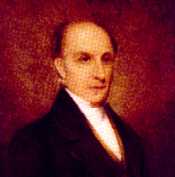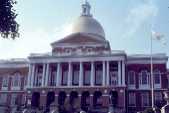 Charles
Bulfinch (1763-1844)
Charles
Bulfinch (1763-1844)
Introduction:
There is perhaps no other body of work which better illustrates the architectural
style of the Federal Period than that of Charles Bulfinch. The young Bostonian,
often called America's first professional architect, was a herald of the
Neo-classical movement that was occurring in Europe at the time. It was
Bullfinch who changed the face of Boston, guiding the town from its stiff
colonial traditions to the charming and flexible Federal Style. His work
would define a city and young nation with the architectural lessons learnt
first hand in Europe as his style spread throughout Boston and to the nation's
capital
Born on August 8, 1763, to Thomas Bulfinch and Susan Apthorp, Charles Bulfinch
was the fourth generation of a prominent Boston family. His architectural
legacy seemed to have been inherited from his mother's family--the Apthorps.
Charles Apthorp, Bulfinch's grandfather, donated much of the money for
King's Chapel in Boston and persuaded his friend, Peter Harrison, to design
the building. Charles Ward Apthorp, an uncle, was the architect of the
controversial Apthorp House in Cambridge, Massachusetts, as well as the
designer of the famous pre-Revolutionary house at West End Avenue and 80th
Street in New York City. Thomas' architectural education began when he
was very young, and he was, no doubt, influenced by his grandfather's architectural
library which housed French editions of Vitruvius, English editions of
Palladio, and folios of William Kent's and Isaac Wares' works. This architectural
pedigree seemed to have had its effect on Thomas, and it was obvious that
architecture delighted the young boy's mind, a point illustrated by rough
architectural doodles that were found on the inside cover of the Latin
grammar schoolbook he received when he was ten years old.
Bulfinch continued his architectural education at Harvard University, which
he entered in 1778, and graduated three years later in a war-thinned class
of twenty-one students. His years as a student were relatively uneventful
and it is generally regarded that his college education contributed little
to his architectural background. The Harvard College library at that time
included the archeological books which helped spark the Neo-classical movement
in Europe: Revett's Antiquities of Athens, Wood's Ruins of Palmyra
and Robert Adam' s The Ruins of the Palace of the Emperor Diocletian
in Spalatro in Dalmatia. Theoretically, Bulfinch graduated in 1781
with an introduction to Neo-classicism and some training in mathematics
and perspective, the foundation for an architectural future. It would take,
however, a two year voyage to Europe to enkindle the architectural flame
that would burn as his passion for the remainder of his life.
From June, 1785, to January, 1787, Bulfinch conducted his grand tour through
the old world visiting London, Paris, Southern France, Northern Italy and
Rome. This voyage, and his exposure to the continent's architecture, only
sealed a fate long decided. While on his grand tour, he was the guest of
such luminaries as Thomas Jefferson and Lafayette in Paris, where he spent
the majority of his time viewing its "buildings and other objects of curiosity".
It seems that the Sage of Monticello took an interest in the youth's education,
specifically architecture, which must have been a mutual interest. In all
likelihood, Jefferson planned Bulfinch's journeys into Southern France
and Northern Italy, for it is the same route the statesman would take years
later during his own pilgrimage. Bulfinch had the good fortune to travel
trough Europe at the height of the Neo-classical movement, observing first
hand the glorious style being developed throughout the capitals of Europe.
It was these images and influences, freshly imprinted in his memory, that
would later manifest themselves in Bullfinch's personal architectural style.

|

|
It was not the revolutionary aspects of Neo-classicism that inspired Bulfinch--as
a young provincial from Boston, he was not a Romantic. It was, rather,
the spatial possibilities and decorative aspects of the genre, as typified
by the English architects Robert Adam and William Chambers, which converted
Bulfinch to Neo-classicism. Their influences that can be seen in Bulfinch's
own personal style. Like Adam, his style is largely interior focused, as
expressed in his room groupings which demonstrate a concern for convenience
and freedom of organization unseen in colonial times. He often employed
a central room as a focal point of a floor plan, and organized the remaining
space around it for function and comfort, customizing each space for a
specific use. Bullfinch moved away from the heavy paneling and carvings
that characterized the interiors of colonial Boston architecture prior
to this time and adopted a light and delicate style, usually through the
medium of plaster. His walls were simple, graceful lines, often accented
by the use of an alcove. Interior decoration followed the Neo-classical
goal of movement through contrast; bare walls were accented with decoration
focused on the ceiling and the mantelpiece in the manner of the English
style.
Bulfinch served the town of Boston in a variety of roles-- as a selectman
and chief of police--but none were as important as his role as an architect.
From his return to the United States in 1787 to 1817, Bulfinch worked constantly
to adorn the city he loved with the ornaments of good architecture. His
labors were rewarded in 1817 when James Madison, after a visit to Boston,
offered him the post of Architect of the nation's Capitol, which he held
until 1830. After his is life of public service was over, Bulfinch
retired to the city he loved where he died in 1844.


 Charles
Bulfinch (1763-1844)
Charles
Bulfinch (1763-1844)

